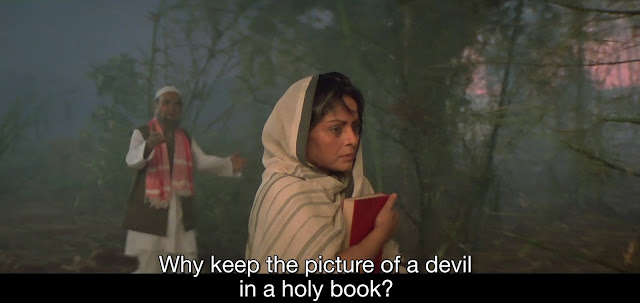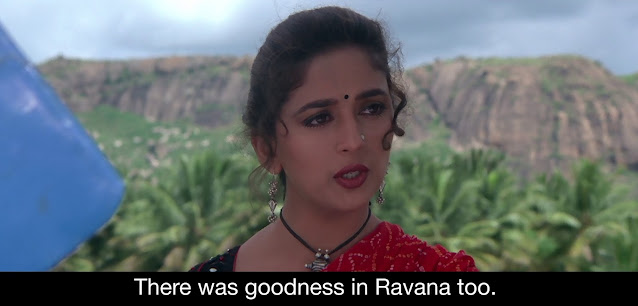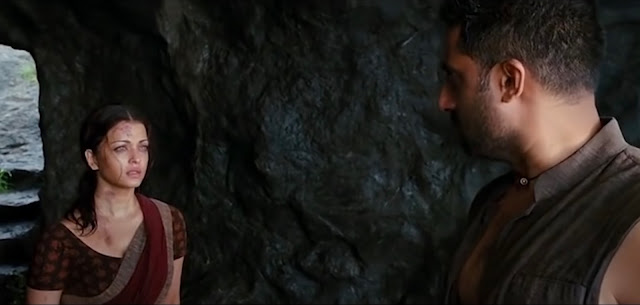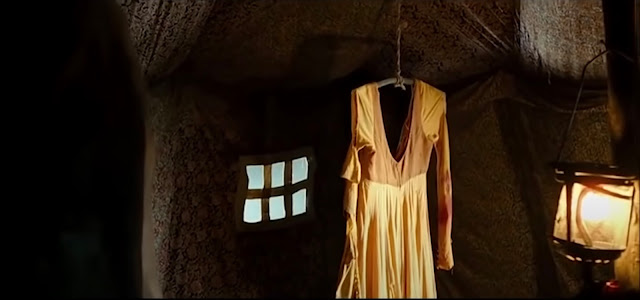
Subhash Ghai's Khal Nayak and Mani Ratnam's Raavan are adapted from the story of Ramayana. There have been many other films based on the epic story of Ram and Sita. However, these two films differ from others as they depict their story through the eyes of Raavan, the reviled demon king. Both films humanize Raavan and portray his conflict and turmoil.

Early in Khal Nayak, Aarti Devi (Rakhee) sits with a photograph of her son Ballu Balram (Sanjay Dutt) in the Ramayana. When her friend Shaukat (A. K. Hangal) sees her, he comments, "Ramayana me Raavan ki photo rakhne se kya fayda." In these early moments, Khal Nayak tells us that it is a tale of the Ramayana. Ballu, the hardened criminal, is Raavan. Ram Kumar Sinha (Jackie Shroff), the police inspector, is Ram. Ganga (Madhuri Dixit), another police inspector in love with Ram, is Sita. Khal Nayak's premise is that there is a nayak (hero) in every khal nayak (villain). "Raavan me bhi to kahin na kahin nayakpan tha," Ganga tells Ballu at some stage, just like there is a Ram in Ballu Balram. Ballu became a khal nayak because he felt wronged by the system. Poverty, unemployment, and his father's rigid principles disillusioned him with life. He wanted to make money and become rich. Taking advantage of Ballu's anger, Roshi Mahanta (Pramod Moutho) lured him towards the path of crime. Ballu, thus, became a ruthless criminal. Khal Nayak explores his journey to becoming a nayak from a khal nayak, and Ganga helps him bring about this change.



Mani Ratnam's Raavan, as the title suggests, is also the tale of Raavan from the Ramayana. Beera (Abhishek Bachchan), who plays a local bandit and a populist hero, is Raavan. "Raavan hai ya Robinhood," a character comments about him. Beera's archnemesis is police inspector Dev (Vikram), befittingly named after the Gods. He is Ram. Beera abducts Dev's wife, Ragini (Aishwarya Rai), who is Sita. Beera and his family suffered great injustice and brutality at the hands of the police. Therefore, he decided to fight against it and ran a parallel government in his village Lal Mati. He became a thorn in the police's eyes. Raavan's premise is, thus, similar to Khal Nayak's where it says that injustice forces people to take the path of crime.

In Khal Nayak, Ballu is captured by Ram, but he manages to escape. Ganga then takes on the mantel of saving the maryada of her Ram. She decides to capture Ballu. She disguises herself as a dancing woman in a troupe. She finds Ballu and runs away with him, hoping that she will lead him to the police. It is here that Khal Nayak does something different. Sita goes to Lanka of her own volition. She is not kidnapped as such by Raavan (Ballu). Traveling with Ballu, however, makes Ganga see his different side. Beneath his hardcore criminal exterior lies a kind man who feels short-changed in life. At one point, he even saves a group of villagers dealing with electoral violence while pretending to be a policeman. Ballu becomes Ram in these moments. He also receives blessings from the entire village for this act. Ganga then starts to develop a feeling of kindness towards Ballu. It is not love per se, as she still loves Ram, but there is definitely some affection for Ballu in her. Ganga also saves him from being shot dead by the police and helps him escape again.

In Raavan, Ragini is kidnapped by Beera, as it happens in Ramayana. She, too, sees another side of Beera when she is held captive. She learns more about the villagers and their goodness and innocence. At one stage, she even becomes one of them when she dresses like them, prompting Beera to call her Mahua. But Ragini also learns about a different side of her Dev and the police. She learns about the inhuman torture meted out by him and other policemen to the villagers. Raavan and Khal Nayak are similar in humanizing Raavan, but they differ in where Raavan shows a darker side of Ram. Beera had a reason for his anger against the police, while Dev was inhumanely violent against the villagers without any major reasons. Even at the time when Beera sends his brother for peace talks, Dev shoots him dead. Dev is portrayed to be more vile and scheming than Beera. In Khal Nayak, Ram is the saint, except perhaps for one instant, when he completely loses his cool and beats the daylights out of Ballu in jail. His peers are stunned by his brutality, but it is the only moment that shows the violent side of Ram.

There is a point in Khal Nayak when Ganga calls Ballu an animal—jaanwar. In response, Ballu comes all shaved and dressed up like a gentleman. He also gifts Ganga an idol of Ram. She imagines the time with her real-life Ram, hoping he will come to her. "Aaja saajan aaja," she sings. Ballu, however, is unaware that Ganga is betrothed to Ram. Once he learns about the object of Ganga's affection, he is jealous and feels betrayed as he has fallen in love with Ganga. In Raavan, too, Ragini compares Beera to an animal. And in a similar staging in Raavan, Ragini prays to the broken statue of Lord Vishnu, asking to not make her weak by showing the goodness of the villagers. The statue is a stand-in for her Dev, her Ram. Beera asks Ragini about her husband. She tells him that Dev is like bhagwaan. Beera replies that he feels jealous of her husband because he gets to be with Ragini. Beera has also fallen in love with her. Jealousy makes him feel like Dev's equal. It is the film's best scene where Beera acknowledges his human and emotional side.


The Agni Pariksha of Sita provides additional Ramayana-based context to the two films. In Khal Nayak, when Ganga protects Ballu from being shot by the police, she is charged with criminal conspiracy. She is put in jail and is called a traitor. The world accuses her of developing feelings for Ballu and tarnishing Ram's image. Even Ram refuses to stand up for her, just as Lord Ram renounced Sita after listening to a laundryman. Ram's Ganga becomes maili. Ganga is put on trial in court. However, Ballu comes to her rescue. He claims in court that she is innocent. It is a telling statement that a criminal's statement carries more weight than an innocent woman's words. Nevertheless, Ganga is released. In this Ramayana, Sita gets to be with Ram. Ballu gets his chance to become a nayak and surrenders.


In Raavan, the Agni Pariksha moment appears when Dev questions Ragini if Beera touched her inappropriately. He also asks her to take a polygraph test. He tries to provoke her because he has an ulterior motive. He, perhaps, knew that Ragini would go to Beera to ask questions, and then he would be able to catch him. In Ramayana, Raavan had tricked Sita by luring her out of Lakshman Rekha. In Raavan, Ram tricks Sita by sending her to Raavan. It is what also happens. Beera is ultimately killed by Dev.

There are other little things in the two films. In Khal Nayak, when Ganga goes with Ballu during Palki Mein Hoke Saawar Chali Re, she drops her ring, hoping that someone will give them to Ram, just as Sita threw her jewelry in Ramayana. When Ram and Ballu fight in the jungle, a bunch of monkeys are shown, who represent the vaanar sena. Ballu feels angered by the events that happened to his sister like Raavan felt wronged by the treatment meted out to his sister Surpanakha by Ram and Lakshman. In Raavan, Dev finds Ragini's clothes when he tries to find Beera's hideout. He has his vaanar sena in the police, and Sanjeevani (Govinda) is the Hanuman. Beera decides to take revenge against Dev because his sister was also assaulted by his policemen. At one particular moment, a police inspector holds Beera's sister by the nose, replicating the events from Ramayana.




In Khal Nayak, Ballu's grandfather was a freedom fighter. His father, too, followed the principled path of honesty. But Ballu and his family remained poor, with no opportunities to climb the social mobility ladder. At one point, he is so frustrated that he even throws mud on his grandfather's name on the road sign outside his house. Therefore, Ballu joins Roshi Mahanta's business as he wants to become rich. He is an advocate of capitalism, but being rich was considered to be evil in that era. Khal Nayak tries to bring him towards the path of nationalism and becoming a good Indian. In Raavan, Beera and other villagers took to arms because of state brutality against them. They have shades of Maoist ideology as they carry out planned attacks against the state. Beera is the leader of Lal Mati, which hints that the soil is controlled by the
Maoist party. Khal Nayak gives a path of redemption to Ballu, while Raavan treats Beera harshly when he is killed.


While Khal Nayak and Raavan are both fascinating films, especially in their treatment of Raavan, I find Khal Nayak to be a superior film. Khal Nayak comments on many other things and seems a little ahead of time. It depicts nature-versus-nurture conflict and the role of parents in making a criminal. When Ballu was a young kid, he used to steal pencils in school. When Roshi Mahanta comes to bribe Ballu's father on Diwali, Ballu steals some crackers from the said bribe. He always had these criminal instincts, but his mother protected him, further developing them. His mother accepts her role in making him a criminal. In another scene towards the end, Ballu's mother goes to a church, hoping that Ballu is hiding there. She questions the church's priest if he has seen her son. The priest asks her about Ballu's appearance. Arti looks around, points towards the painting of Jesus Christ with his long hair, and tells the priest that Ballu looks like Jesus. Ballu, too, has long hair. In this sense, Khal Nayak also likens Ballu to God. The father tells her that maybe her son has lost his way, and he will soon be back. Ballu did lose his way in life when he went on the path of crime. But the most memorable thing for me about Ballu in the film appears during Khal Nayak Hoon Main song when he reveals how he lost his way in life. Hai pyaar kya mujhako kya khabar, bas yaar nafrat ke laayak hoon main. It is a stunning moment where a villain sings about love while wearing an eye-popping red heart. As we see, there is a heart in Raavan as well.
Dialogue of the Day:
"Hum jal rahe hai toh lag raha hai humse bada koi hai hi nahi. Jalan kismatvalon ko naseeb hoti hai."
—Beera, Raavan
—Beera, Raavan




No comments:
Post a Comment
Post a comment